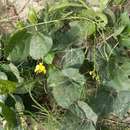en
names in breadcrumbs


Vigna is a genus of plants in the legume family, Fabaceae, with a pantropical distribution.[1] It includes some well-known cultivated species, including many types of beans. Some are former members of the genus Phaseolus. According to Hortus Third, Vigna differs from Phaseolus in biochemistry and pollen structure, and in details of the style and stipules.
Vigna is also commonly confused with the genus Dolichos, but the two differ in stigma structure.[2]
Vigna are herbs or occasionally subshrubs. The leaves are pinnate, divided into 3 leaflets. The inflorescence is a raceme of yellow, blue, or purple pea flowers. The fruit is a legume pod of varying shape containing seeds.[3]
Familiar food species include the adzuki bean (V. angularis), the black gram (V. mungo), the cowpea (V. unguiculata, including the variety known as the black-eyed pea), and the mung bean (V. radiata). Each of these may be used as a whole bean, a bean paste, or as bean sprouts.
The genus is named after Domenico Vigna, a seventeenth-century Italian botanist and director of the Orto botanico di Pisa.[4]
Root tubers of Vigna species have traditionally been used as food for Aborigines of the Northern Territory.[5]
The genus Vigna contains at least 90 species,[1][3][6] including:
Vigna is a genus of plants in the legume family, Fabaceae, with a pantropical distribution. It includes some well-known cultivated species, including many types of beans. Some are former members of the genus Phaseolus. According to Hortus Third, Vigna differs from Phaseolus in biochemistry and pollen structure, and in details of the style and stipules.
Vigna is also commonly confused with the genus Dolichos, but the two differ in stigma structure.
Vigna are herbs or occasionally subshrubs. The leaves are pinnate, divided into 3 leaflets. The inflorescence is a raceme of yellow, blue, or purple pea flowers. The fruit is a legume pod of varying shape containing seeds.
Familiar food species include the adzuki bean (V. angularis), the black gram (V. mungo), the cowpea (V. unguiculata, including the variety known as the black-eyed pea), and the mung bean (V. radiata). Each of these may be used as a whole bean, a bean paste, or as bean sprouts.
The genus is named after Domenico Vigna, a seventeenth-century Italian botanist and director of the Orto botanico di Pisa.